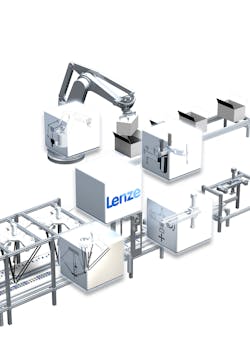Two technology areas that have clearly been trending in the automation sector recently are machine-design building blocks and robotics. A new software release from Lenze is bringing these two trends together.
The company has released standardized and reusable robotics software modules that can be used with its FAST application toolbox for machine automation and control designs. According to Lenze, these robotics modules allow mechanical engineers to integrate kinematics into machines tailored to specific material handling tasks.
“Robotics requires kinematics and path planning. By blending expertise in robotics and motion control, Lenze FAST robotics modules eliminate requirements for proprietary systems and complex interface programming for path planning,” said Craig Dahlquist, automation team leader, Lenze Americas.
The purpose of these robotics software modules is to help make it easier to integrate robots into an overall automation system and control them during operation of equipment. Considering the potential for the growing use of robotics across industry, the potential need for such software will likely increase. As a case in point, consider the recent increase in robotics orders by the automotive industry, which has long been a leader in the use of robotics. As noted in my recent blog post on the state of the manufacturing industry in America, the U.S. automotive industry has increased its robotics orders 45 percent in the past year.
The Lenze modules use PLCopen Part 4 specifications for path planning, which is said to enable implementation of functionalities such as buffer mode, blending, look-ahead, and motion smoothing commands. The robotics core also supports standard motion commands, such as linear, circular, spline and point-to- point.
Dahlquist points out that the Lenze modules simplify robotic programming through use of parameterization to enable pick-and-place and other customized movements, without requiring previous knowledge of robotics. “The robot is not instructed how to move until the kinematic model has been assigned to the motion producing modules,” he said. “So, the path can be planned independently of the kinematics. Reprogramming is unnecessary if kinematics change—only relevant parameters need to be entered.”
Lenze offers integrated kinematic modules for Delta2, Delta3, buckling arm and SCARA robots, as well as modules for different types of gantry robots. In addition to six main axes, auxiliary axes can be programmed for implementation of speed-dependent processes, such as glue application, welding-head guidance, tool operation, and synchronization of a robot to a conveyor belt.
Dahlquist adds that a visualization system for testing purposes is provided in the Lenze PLC Designer for every FAST technology module.
Leaders relevant to this article:


